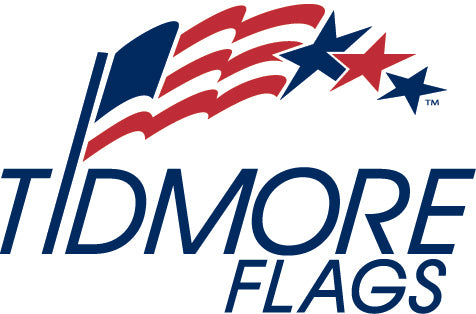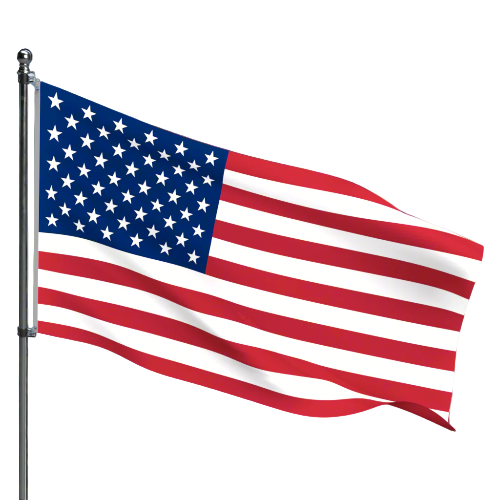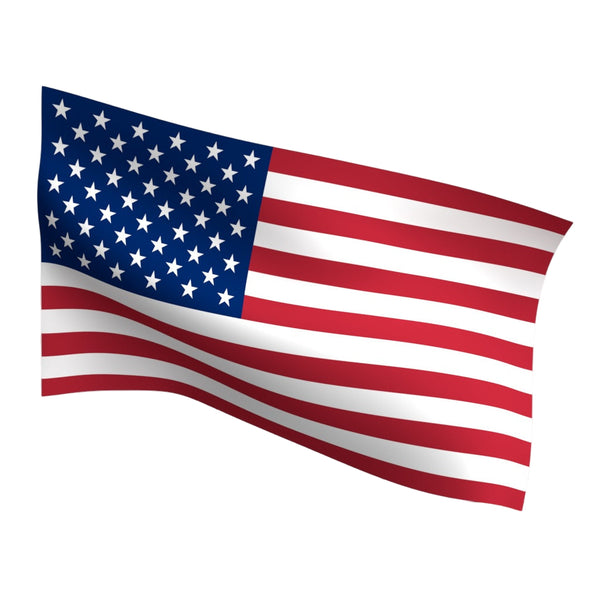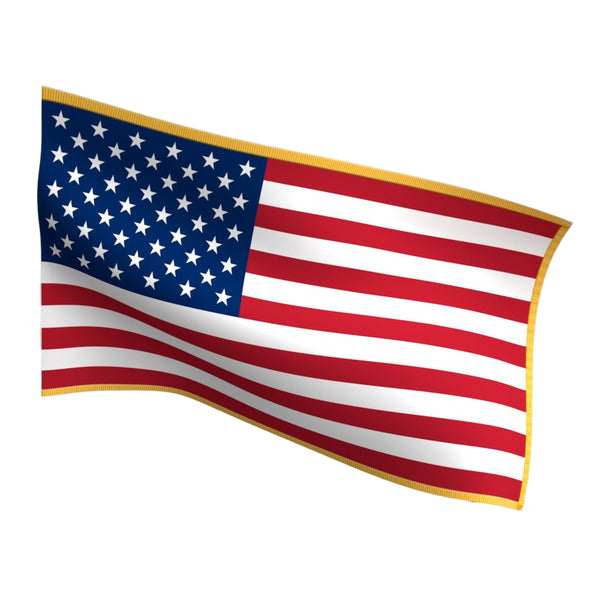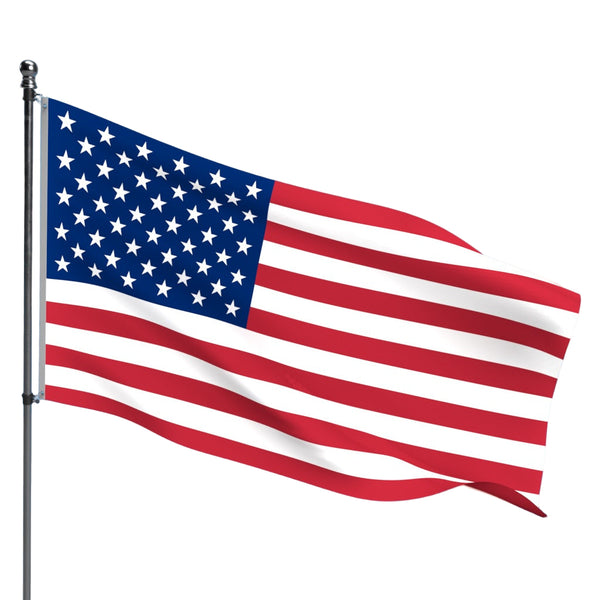The Complete Guide to U.S. Flag Etiquette and Display Rules

Share
The American flag represents freedom, unity, and sacrifice. Displaying it properly is more than tradition — it’s a sign of respect for those who have served and for the values our nation stands for. This complete guide explains how to correctly fly, fold, and care for the U.S. flag according to the U.S. Flag Code.
Understanding the U.S. Flag Code
The U.S. Flag Code was established in 1942 to set the official guidelines for displaying and handling the American flag. While it’s not legally enforced in most cases, following these rules demonstrates patriotism and honor for the flag and country.
Proper Display of the American Flag
Outdoor Display
- The flag should be displayed from sunrise to sunset. If flown at night, it must be properly illuminated.
- Always hoist the flag briskly and lower it ceremoniously.
- When displayed on a pole, the union (blue field with stars) should always be at the peak of the staff.
- The flag should never touch the ground, floor, or water.
- During inclement weather, use an all-weather flag designed to resist wind and rain.
Wall or Flat Display
- When hung vertically or horizontally on a wall, the union should be at the top left corner from the viewer’s perspective.
- For windows or stages, the union should always appear in the upper left to those viewing it.
Half-Staff Protocol
Flying the flag at half-staff honors and mourns national figures or tragic events. The flag should first be raised to the peak, then lowered to half-staff. On Memorial Day, it is flown at half-staff until noon, then raised to full staff for the remainder of the day.
Indoor and Ceremonial Display
For indoor or ceremonial use, such as in schools, churches, or auditoriums, the flag should be displayed with dignity. Presentation sets often include a nylon indoor flag with fringe, a polished pole, an eagle topper, and a weighted stand.
- When displayed with other flags on staffs, the U.S. flag should always be placed to its own right (the viewer’s left).
- No other flag should be placed above or to the right of the U.S. flag.
- If displayed on a stage or platform, the flag should be placed to the speaker’s right.
Folding the American Flag
The U.S. flag is folded into a triangle shape, representing the tri-cornered hats worn during the Revolutionary War. Each fold carries symbolic meaning, honoring life, liberty, and the remembrance of those who served.
- Two people hold the flag waist-high and fold it in half lengthwise.
- Fold it lengthwise again, keeping the union on the outside.
- Begin triangular folds from the striped end until only the blue field is visible.
When properly folded, only the blue field with stars should show — symbolizing honor and remembrance.
When to Retire a Flag
A flag should be retired when it is worn, faded, or torn beyond repair. According to the Flag Code, the preferred method of disposal is a respectful burning ceremony. Many local veterans’ organizations, such as the American Legion or VFW, offer flag retirement services.
Common Mistakes to Avoid
- Never use the flag as apparel, bedding, or drapery.
- Do not print or embroider the flag on disposable items.
- The flag should not be used for advertising or commercial decoration.
- Do not let the flag touch the ground or trail from a vehicle.
Caring for Your Flag
To keep your flag looking its best:
- Use nylon flags for light to moderate winds.
- Choose polyester flags for high-wind or coastal areas.
- Hand wash or spot clean when needed, and store in a dry place.
Show Your Patriotism with Pride
Displaying the American flag is one of the most meaningful ways to show love for our country. By following proper etiquette, you help preserve the dignity and symbolism that the flag represents.
At Tidmore Flags, we’re proud to offer a full range of outdoor flags, indoor presentation sets, and flagpoles — all Made in the USA and built to honor the spirit of America.
The Complete Guide to U.S. Flag Etiquette and Display Rules
The American flag represents freedom, unity, and sacrifice. Displaying it properly is more than tradition — it’s a sign of respect for those who have served and for the values our nation stands for. This complete guide explains how to correctly fly, fold, and care for the U.S. flag according to the U.S. Flag Code.
Understanding the U.S. Flag Code
The U.S. Flag Code was established in 1942 to set the official guidelines for displaying and handling the American flag. While it’s not legally enforced in most cases, following these rules demonstrates patriotism and honor for the flag and country.
Proper Display of the American Flag
Outdoor Display
- The flag should be displayed from sunrise to sunset. If flown at night, it must be properly illuminated.
- Always hoist the flag briskly and lower it ceremoniously.
- When displayed on a pole, the union (blue field with stars) should always be at the peak of the staff. Unless a Half Staff order has been placed. Guide to Half-Staff American Flag Etiquette
- The flag should never touch the ground, floor, or water.
- During inclement weather, use an all-weather flag designed to resist wind and rain.
Wall or Flat Display
- When hung vertically or horizontally on a wall, the union should be at the top left corner from the viewer’s perspective.
- For windows or stages, the union should always appear in the upper left to those viewing it.
Half-Staff Protocol
Flying the flag at half-staff honors and mourns national figures or tragic events. The flag should first be raised to the peak, then lowered to half-staff. On Memorial Day, it is flown at half-staff until noon, then raised to full staff for the remainder of the day.
Indoor and Ceremonial Display
For indoor or ceremonial use, such as in schools, churches, or auditoriums, the flag should be displayed with dignity. Presentation sets often include a nylon indoor flag with fringe, a polished pole, an eagle topper, and a weighted stand.
- When displayed with other flags on staffs, the U.S. flag should always be placed to its own right (the viewer’s left).
- No other flag should be placed above or to the right of the U.S. flag.
- If displayed on a stage or platform, the flag should be placed to the speaker’s right.
Folding the American Flag
The U.S. flag is folded into a triangle shape, representing the tri-cornered hats worn during the Revolutionary War. Each fold carries symbolic meaning, honoring life, liberty, and the remembrance of those who served.
- Two people hold the flag waist-high and fold it in half lengthwise.
- Fold it lengthwise again, keeping the union on the outside.
- Begin triangular folds from the striped end until only the blue field is visible.
When properly folded, only the blue field with stars should show — symbolizing honor and remembrance.
When to Retire a Flag
A flag should be retired when it is worn, faded, or torn beyond repair. According to the Flag Code, the preferred method of disposal is a respectful burning ceremony. Many local veterans’ organizations, such as the American Legion or VFW, offer flag retirement services.
Common Mistakes to Avoid
- Never use the flag as apparel, bedding, or drapery.
- Do not print or embroider the flag on disposable items.
- The flag should not be used for advertising or commercial decoration.
- Do not let the flag touch the ground or trail from a vehicle.
Caring for Your Flag
To keep your flag looking its best:
- Use nylon flags for light to moderate winds.
- Choose polyester flags for high-wind or coastal areas.
- Hand wash or spot clean when needed, and store in a dry place.
Show Your Patriotism with Pride
Displaying the American flag is one of the most meaningful ways to show love for our country. By following proper etiquette, you help preserve the dignity and symbolism that the flag represents.
At Tidmore Flags, we’re proud to offer a full range of outdoor flags, indoor presentation sets, and flagpoles — all Made in the USA and built to honor the spirit of America.
